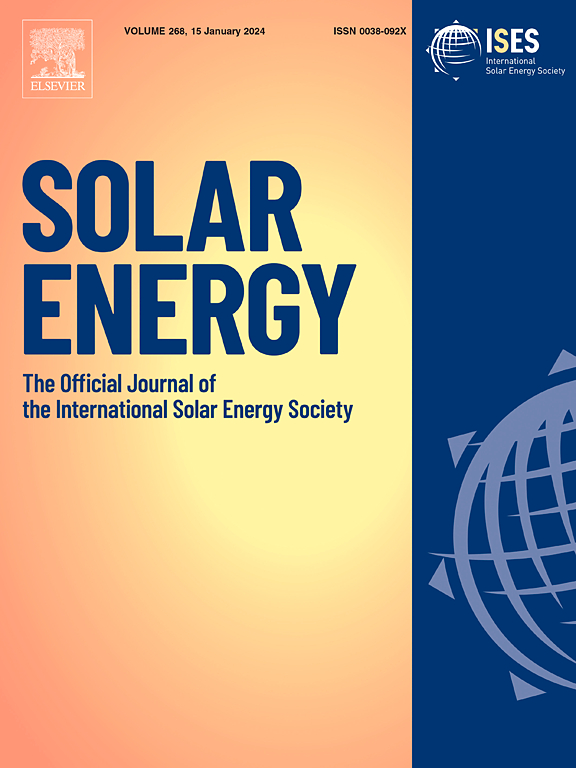提高聚光光伏电池在最高太阳能聚光比下的温度均匀性和发电量
IF 6
2区 工程技术
Q2 ENERGY & FUELS
引用次数: 0
摘要
聚光光伏系统(CPVs)将太阳光集中在太阳能电池上发电。在环境辐射不足的情况下,提高浓度比可以使系统保持较高的输出功率。对于有效面积为1 cm2的太阳能电池,室外实验的浓度比通常不超过1000 ×。在这项研究中,开发了一种新型的超高聚光光伏系统(UHCPV),能够承受高达2500倍的太阳能聚光比。为了提高光斑的均匀性,采用了导光板。采用微通道液冷散热器和离心风扇分别对电池的上下表面进行冷却。通过数值模拟和室外实验研究,验证了导光和冷却模块的有效性。结果表明,在浓度比为900倍时,与单微通道液冷散热器相比,电池表面的最高温度从84.3℃降低到63.0℃。在2500 ×的超高浓度比下,最高表面温度达到88.2℃。此外,还进行了室外实验,测量了浓度比在900 ~ 2500倍范围内的电性能。当浓度比为1600 ×时,系统最大电功率为23.21 W。本文章由计算机程序翻译,如有差异,请以英文原文为准。
Improving the temperature uniformity and power generation of a concentrated photovoltaic cell under highest solar concentration ratios
Concentrated photovoltaic systems (CPVs) concentrate sunlight on solar cells to generate electricity. Increasing the concentration ratio can keep the system at high power output when the ambient radiation is insufficient. For solar cells with an effective area of 1 cm2, the concentration ratio of outdoor experiments usually does not exceed 1,000× . In this study, a novel ultra-high concentrated photovoltaic system (UHCPV) capable of withstanding a solar concentration ratio as high as 2,500× was developed. A light guide was incorporated to improve the uniformity of the light spot. A microchannel liquid cooling radiator and a centrifugal fan were used to cool the upper and lower surfaces of the cell, respectively. The effectiveness of the light guide and cooling module was demonstrated through numerical simulation and outdoor experimental research. The results indicate that at a concentration ratio of 900×, the maximum temperature of the cell surface decreased from 84.3 °C to 63.0 °C compared with that of a single microchannel liquid cooling radiator. At an ultrahigh concentration ratio of 2,500×, the maximum surface temperature reached 88.2 °C. Additionally, outdoor experiments were conducted to measure the electrical performance at concentration ratios ranging from 900× to 2,500× . When the concentration ratio was 1,600×, the maximum electrical power of the system was 23.21 W.
求助全文
通过发布文献求助,成功后即可免费获取论文全文。
去求助
来源期刊

Solar Energy
工程技术-能源与燃料
CiteScore
13.90
自引率
9.00%
发文量
0
审稿时长
47 days
期刊介绍:
Solar Energy welcomes manuscripts presenting information not previously published in journals on any aspect of solar energy research, development, application, measurement or policy. The term "solar energy" in this context includes the indirect uses such as wind energy and biomass
 求助内容:
求助内容: 应助结果提醒方式:
应助结果提醒方式:


